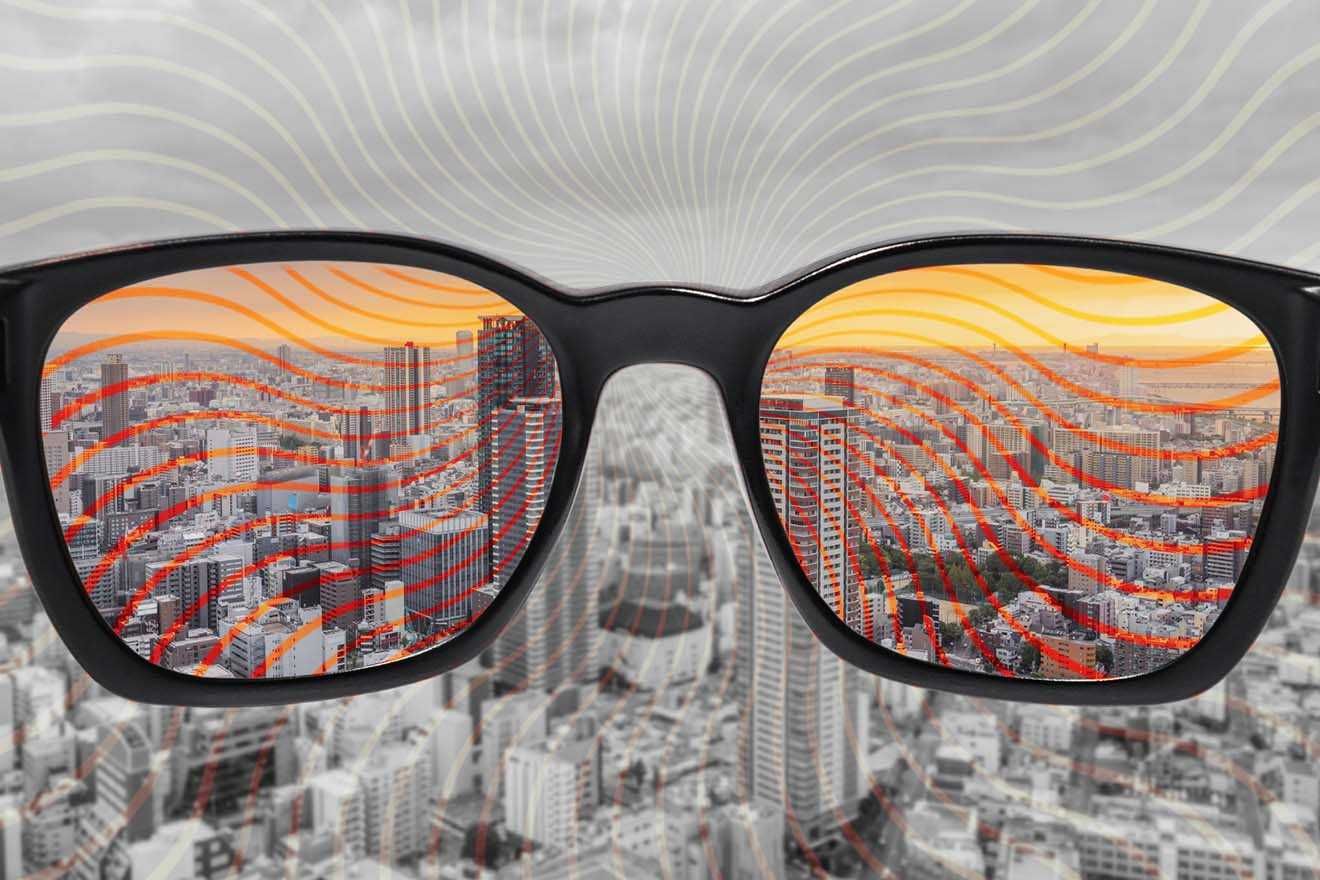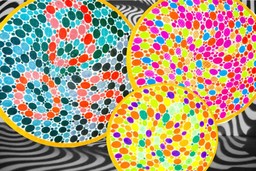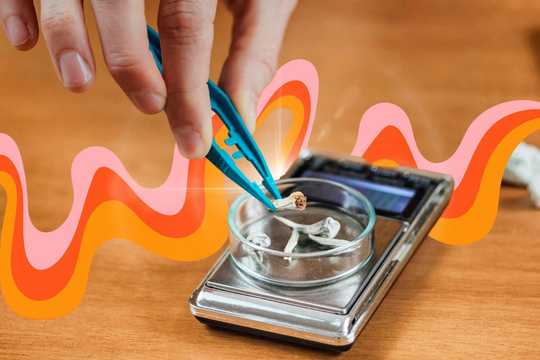Enhanced color perception is one of the common effects many people talk about during a psychedelic experience. Synesthesia is colored hearing meaning a person sees sounds, noises, voices, and/or music as colors.
Psychedelics such as LSD and psilocybin affect the visual cortex in the brain and can cause visual distortions. A study performed on mice aimed to understand how psychedelic drugs create hallucinations. After the mice were given a hallucinogenic drug called DOI (4-iodo-2,5-dimethoxyphenylisopropylamine), they were shown computer images of geometrical patterns of vertical and horizontal lines.
Their brain activity was measured to understand how the serotonin 2A receptor affected the visual system. The results showed that neural signalling in the primary visual cortex for the mice on drugs was weaker and more disorganized than the control mice, even though the information being sent was the same. As a result of the reduced visual process, the brain may start to fill in the blanks.
As told to Live Science, the study researcher, Cris Niell, a neuroscientist at the University of Oregon shared:
“The brain might start over-interpreting, or misinterpreting. And that could end up as a hallucination.”
Although it’s not possible to know whether the mice were actually hallucinating, the study serves as the initial groundwork in understanding the neural processes involved in the visual distortions associated with psychedelic use.
Learn more about how psychedelic therapy could revolutionize mental health and treat a variety of psychological disorders.
What if the person is color blind and cannot differentiate between red and green or blue and yellow? Would taking a psychedelic trip help them with their condition?
This article discusses the current research behind the association between color blindness and psychedelic substances.
What is Color Blindness?
Color blindness is an uncommon condition where a person does not see colors the same way as most people. The person is unable to differentiate between specific colors because the cone cells located in their eyes do not function properly or are damaged.
It’s easy to determine whether someone is color blind. The Ishihara color blindness test is a series of pictures with dots of colors. Numbers are embedded into the images; if the person cannot see them, they most likely have the condition.
There are two types of color blindness:
- Red/Green Color Blindness: This is the most common type of color blindness and occurs in males more than females. A person cannot tell the difference between reds and greens and sees them as a brownish color. Blue/Yellow color blindness also occurs but is extremely rare.
- Acquired Color Blindness: This form of color blindness is developed due to an eye disease such as optic nerve or retinal disorders.
The term for the condition is misleading because a person who is color blind does not necessarily mean they see things as black and white in a colorless world. Most can tell the difference between most colors.
Currently, there are no medical treatments for color blindness. However, there are special glasses and contact lenses that can be helpful. Eye conditions or certain drugs may cause color blindness; treating the disease or avoiding the drug can improve color blindness.
Psychedelic Use May Improve Color Blindness
The researchers received multiple responses from participants of their previous research studies describing improvements in their color blindness following psychedelic use. For instance, they shared a participant’s comment:
“All my life I suffered from red-dichromacy/protanopia … after psilocybin I viewed Monet’s San Giorgio Maggiore at Dusk, a painting which I had previously seen as a dull mass of brown and blue. All of the colours I was previously unable to see were there on the screen, and the emotion that I felt made me unable to speak for about half an hour.”
Therefore, the researchers decided to analyze the responses to the 2017 Global Drugs Survey, the largest annual online drug survey in the world.
Specifically, the study looked at the questions that asked participants who reported using LSD or psilocybin about whether their color blindness improved after their recreational psychedelic use. There were a total of 47 responses with 23 that had details about improvements in color blindness.
Results of the Research
The results showed that 39% of participants who described changes in color perception experienced improvement from three days to years after the drug’s effect subsided.
The researchers explained that the change in color perception may be due to enhanced connections between the linguistic and visual areas of the brain caused by psychedelics, allowing the new photisms and preexisting concepts of color to be linked. Photism is a form of synesthesia where a false or hallucinogenic visual sensation occurs.
A single case report showed improvements in color blindness in a 35-year-old male following psilocybin use. At baseline, the subject self-administered an Ishihara Test to assess the severity and duration of his color vision deficiency (CVD); he scored a 14, meaning he had mild red-green CVD.
The subject ingested 5 grams of psilocybin and self-administered Ishihara tests 12 hours following, which showed a score of 15. Then he conducted additional color blindness self-tests for the next 4 months. The data showed his improvements in CVD peaked at 8 days with a score of 19 and were sustained for at least 16 days after psilocybin use.
However, after day 16, the subject reported taking other hallucinogenic substances, which confounded any further observations.
Potential Long-Term Risks
The long-term effects of psychedelic use have not been researched thoroughly due to legal restrictions around these drugs.
An old study published in the 1980s compared color vision between LSD users and controls two years after their last drug experience. It showed that the control group performed significantly better on the color test than LSD users. It concluded that LSD users may have chronic and irreversible impairment in color vision.
Further Research
Therefore, there is a limited number of studies looking at the association between psychedelics and color blindness. Understanding further about this relationship needs additional studies and research. However, this may not mean it will happen any time soon.
Those who can see the full spectrum of colors may think that those who cannot are missing out. However, most people with color blindness can differentiate between most colors. It is uncommon and not often a debilitating condition. Most people with it can function normally without it negatively affecting their day-to-day life.
In an interview with Vice, Ilsa Jerome, a clinical researcher for the Multidisciplinary Association for Psychedelic Studies (MAPS), was asked whether there will be more research ahead on blindness and psychedelic use. She shared the following response:
“It’s still difficult and expensive to conduct these studies, so I’m not hopeful that the renaissance in psychedelic research will lead [to] more studies on the blind or people with other sensory impairments. There’s very little impetus: The assumption that these questions are “trivial” may be correct — the effects of psychedelics extend far beyond sensory changes. The more profound changes in emotion and ego matter much more — and, as we’ve said, they appear to be the same whether you’re blind or not.”
Prioritizing this particular condition may not be at the forefront of the scientific research community. The current focus is on advances in treating more pertinent illnesses and chronic disorders that will substantially improve the health and wellness of the global population.
Follow your Curiosity
Sign up to receive our free psychedelic courses, 45 page eBook, and special offers delivered to your inbox.References
Abraham, H. D. (1982). A Chronic Impairment of Colour Vision in Users of LSD. British Journal of Psychiatry, 140(5), 518–520. https://doi.org/10.1192/bjp.140.5.518
Anthony, J., Winstock, A., Ferris, J., & Nutt, D. (2020). Improved colour blindness symptoms associated with recreational psychedelic use: Results from the Global Drug Survey 2017. Drug Science, Policy and Law, 6, 205032452094234. https://doi.org/10.1177/2050324520942345
Barnett, B. S., Noah Wiles Sweat, & Hendricks, P. S. (2023). Case report: Prolonged amelioration of mild red-green color vision deficiency following psilocybin mushroom use. Drug Science, Policy and Law, 9, 205032452311725–205032452311725. https://doi.org/10.1177/20503245231172536
Benson, T. (2017, April 20). What Happens When Blind People Take Psychedelics. Vice. https://www.vice.com/en/article/yp7wkx/what-happens-when-blind-people-take-psychedelics
How Color Blindness Is Tested. (2017, August 25). How Color Blindness Is Tested. American Academy of Ophthalmology. https://www.aao.org/eye-health/diseases/how-color-blindness-is-tested
Mayo Clinic Staff. (2018). Poor color vision — Symptoms and causes. Mayo Clinic. https://www.mayoclinic.org/diseases-conditions/poor-color-vision/symptoms-causes/syc-20354988
Michaiel, A. M., Parker, P. R. L., & Niell, C. M. (2019). A Hallucinogenic Serotonin-2A Receptor Agonist Reduces Visual Response Gain and Alters Temporal Dynamics in Mouse V1. Cell Reports, 26(13), 3475–3483.e4. https://doi.org/10.1016/j.celrep.2019.02.104
National Eye Institute. (2019, July 3). Color Blindness | National Eye Institute. Nih.gov; National Eye Institute. https://www.nei.nih.gov/learn-about-eye-health/eye-conditions-and-diseases/color-blindness
Pappas, S. (2019). How Psychedelic Drugs Create Such Weird Hallucinations. Livescience.com. https://www.livescience.com/65074-psychedelic-drugs-hallucinations-mouse.html







